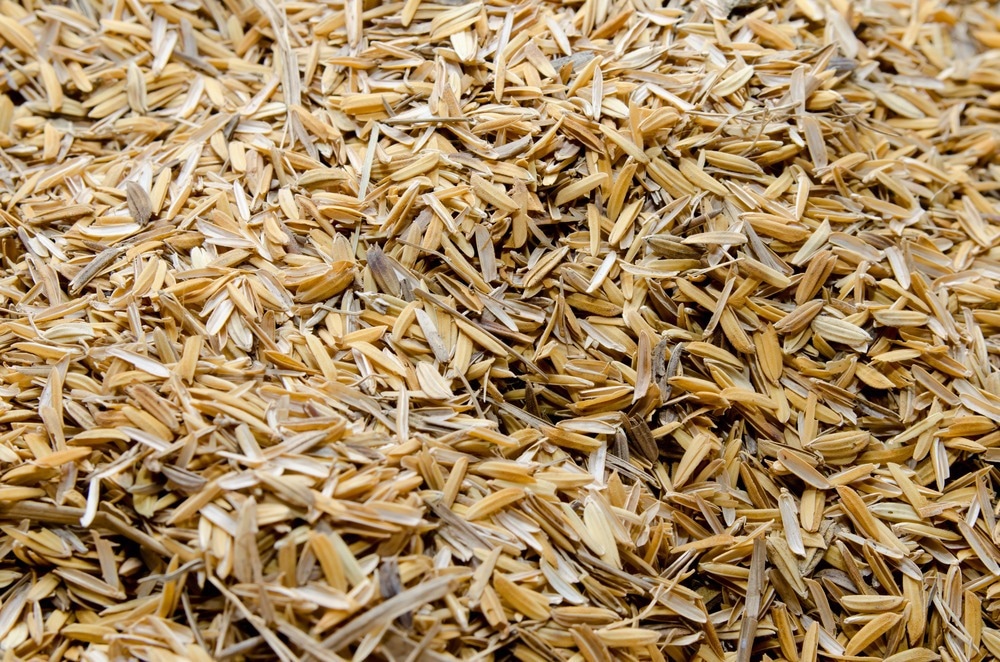In an article published in the journal Materials Today: Proceedings, a nanofluid based on organic material derived from bio-origin resources was developed with enhanced physical properties.

Study: Influence of rice husk based nanosilica in rheological and stability of binary mixture fluid. Image Credit: Sakdinon Kadchiangsaen/Shutterstock.com
Nanosilica with low density was prepared from rice husk via a simple two-step thermal process using a solar-assisted plasma furnace which required low temperature and reaction time. The prepared nanosilica was characterized for its morphology and physical properties by using X-ray diffraction (XRD) and transmission electron microscopy (TEM).
Nanosilica and ethylene glycol (EG)/water binary mixture-based nanofluids were prepared at concentrations between 0.2 to 1 volume% of nanosilica. Nanofluid’s flow curve showed that with the minimum inclusion of nanosilica, the fluid stress enhanced significantly. Furthermore, measuring the dynamic viscosity revealed that, compared to a virgin fluid, the addition of nanosilica stabilized the fluid properties.
The rheological properties and stability of the nanofluids with the incorporation of nanoparticles were also studied using ultraviolet-visible (UV-Vis) spectroscopy. The present method is a greener approach to nanofluid preparation, derived from eco-friendly and natural resources with a low nanoparticle percentage.
Nanosilica in Nanofluids
Rice husk is the by-product of rice. Due to low density and less commercial interest in rice husk, its handling and transportation are problematic, which creates disposal and serious environmental problems. According to the previously conducted experiments, the main element in rice husk ash is silicon (87.7% as silica (SiO2)), followed by potassium (5.4% as potassium oxide) and phosphorous (3.7% as phosphorus pentoxide), so rice husk ash is likely an abundant SiO2 source.
The limitation of poor heat transfer efficiency of conventional base fluid is overcome by adding nanosized solid particles or nanoparticles into the base fluid, helping to improve heat transfer and rheological properties. Compared to conventional fluids, nanofluids are more stable due to the Brownian motion of nanoparticles in liquid.
Nanofluids have novel properties that make them potentially useful in many fields, including microelectronics, fuel cells, pharmaceutical processes, hybrid-powered engines, engine cooling/vehicle thermal management, domestic refrigerator, chiller, heat exchanger, and grinding, machining, and boiler flue gas temperature reduction.
Among various nanofluids reported, nanosilica-based nanofluids were reported to be stable for over 72 hours without showing any sedimentation of nanoparticles. To this end, a nanosilica-based nanofluid derived from rice husk is a new approach to synthesizing nanofluids. Nanosilica is also called silica dust or quartz dust, characterized by its high SiO2 percentage, over 99%.
These nanosilica-based nanofluids showed outstanding resistance to abrasion, better electric insulation, and excellent thermal conductivity. Moreover, dispersion of a high concentration of nanosilica in nanofluids leads to enhanced thermal conductivity.
Rice Husk-Based Nanosilica
SiO2 nanofluid derived from rice husk was previously unreported. Hence, in the present study, the nanoparticles were prepared from rice husk via a solar-assisted plasma furnace. The physical properties, including stability and rheology of SiO2 nanofluid, were investigated using UV-Vis spectroscopy.
The morphology and size of the prepared nanosilica were analyzed using TEM images that revealed an irregular shape with particle size in the range of 25 to 50 nanometers. Instead of being dispersed in nanofluids, these nanosilica particles agglomerated into spongy granules of high density. The XRD pattern revealed that nanosilica particles showed a broad peak at 2θ of 21 degrees, associated with amorphous nanosilica. Moreover, the absence of sharp peaks in XRD patterns indicates the lack of a crystalline phase.
Samples of nanofluids with varying content of nanosilica were prepared as nanosilica–binary mixture nanofluids, and the flow curves of these prepared nanofluids were observed at a temperature of 298.15 kelvin showing that the shear stress linearly increased with shear rate. The binary mixture showed improved fluid properties by itself that was further improved by adding nanosilica with a portion as small as 0.2 vol%.
The UV-Vis spectrum was used to evaluate nanofluid stability with varying content of nanoparticles. The nanofluids based on nanosilica did not show any precipitation and were stable for up to 5 weeks, and the presence of a peak at 265 nanometers in UV-Vis spectra confirmed the presence of SiO2.
Conclusion
To summarize, a binary mixture of water and EG was prepared through an ultrasonication process with varying concentrations of 0 to 1 volume%. The synthesized nanosilica was characterized using TEM and XRD analytical techniques. Moreover, UV–Vis, and rheology helped analyze the performance and stability of SiO2 nanofluids.
TEM images showed the particle size of nanosilica in the range of 25 to 50 nanometers. The XRD characterization confirmed the amorphous arrangement of nanosilica. SiO2 nanofluids improved the base fluid’s properties, wherein the shear stress improved linearly with the increasing concentration of SiO2 nanofluids.
Furthermore, the dynamic viscosity curves graph showed an increasing trend in the viscosity of SiO2 nanofluids with concentration. The stability studies performed using UV–Vis spectroscopy showed that nanofluids were stable for up to 5 weeks.
Reference
Iskandar, W. M. E., Ong, H. R., Khan, M. M. R., Ramli, R. (2022). Influence of rice husk based nanosilica in rheological and stability of binary mixture fluid. Materials Today: Proceedings. https://www.sciencedirect.com/science/article/pii/S2214785322046557
Disclaimer: The views expressed here are those of the author expressed in their private capacity and do not necessarily represent the views of AZoM.com Limited T/A AZoNetwork the owner and operator of this website. This disclaimer forms part of the Terms and conditions of use of this website.